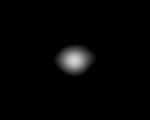Adrastea (moon) facts for kids

Image of Adrastea taken by Galileo's solid state imaging system between November 1996 and June 1997.
|
|
| Discovery | |
|---|---|
| Discovered by | David C. Jewitt G. Edward Danielson |
| Discovery date | July 8, 1979 |
| Orbital characteristics | |
|
Mean orbit radius
|
129,000 km |
| Eccentricity | 0.0015 |
| 0.29826 d (7 h 9.5 min) | |
|
Average orbital speed
|
31.378 km/s |
| Inclination | 0.03° (to Jupiter's equator) |
| Satellite of | Jupiter |
| Physical characteristics | |
| Dimensions | 20×16×14 km |
|
Mean radius
|
8.2 ± 2.0 km |
| Volume | ~2,345 km³ |
| Mass | ~2×1015 kg |
|
Mean density
|
0.86 g/cm³ (assumed) |
| ~0.002 m/s² (0.0004 g) | |
| ~0.008 km/s | |
| synchronous | |
| zero | |
| Albedo | ~0.1 ± 0.045 |
| Temperature | ~122 K |
Adrastea, also known as Jupiter XV, is one of Jupiter's many moons. It's the second closest moon to the giant planet.
Scientists David C. Jewitt and G. Edward Danielson discovered Adrastea in 1979. They found it in pictures taken by the Voyager 2 spacecraft. At first, it was called S/1979 J 1. In 1983, it was officially named Adrastea. This name comes from a mythological figure, Adrastea, who was a daughter of the Roman god Jupiter.
Adrastea was special because it was the first moon ever found using images from a spacecraft. Before this, all moons were discovered using telescopes on Earth.
What is Adrastea Like?
Adrastea is not perfectly round like a ball. It has an irregular shape, measuring about 20 kilometers (12 miles) long, 16 kilometers (10 miles) wide, and 14 kilometers (9 miles) thick.
Scientists don't know exactly what Adrastea is made of. They also don't know its exact mass. However, they guess it might be similar to another moon, Amalthea. If so, Adrastea could be mostly made of water ice. It might also have some empty spaces, called porosity, inside it.
We don't have clear pictures of Adrastea's surface. This means we don't know what its mountains, craters, or other features look like. The images we have are not very detailed.
Adrastea's Orbit Around Jupiter
Adrastea is the smallest of Jupiter's four inner moons. It orbits very close to Jupiter, about 129,000 kilometers (80,000 miles) away. This distance is about 1.8 times Jupiter's own radius.
Adrastea actually orbits inside Jupiter's Main Ring. Its path around Jupiter is almost a perfect circle. It also stays very close to Jupiter's equator. This means its orbit is not tilted much compared to the planet.
How We Explored Adrastea
Adrastea was first spotted in images from the Voyager 1 and 2 missions. However, in those pictures, it looked like just a tiny dot.
Later, the Galileo spacecraft got closer to Jupiter. It was able to take better pictures of Adrastea. These images helped scientists see its general shape. Even with Galileo, the pictures were still not super clear. We hope future missions might give us an even better look at this small moon!
See also
 In Spanish: Adrastea (satélite) para niños
In Spanish: Adrastea (satélite) para niños


